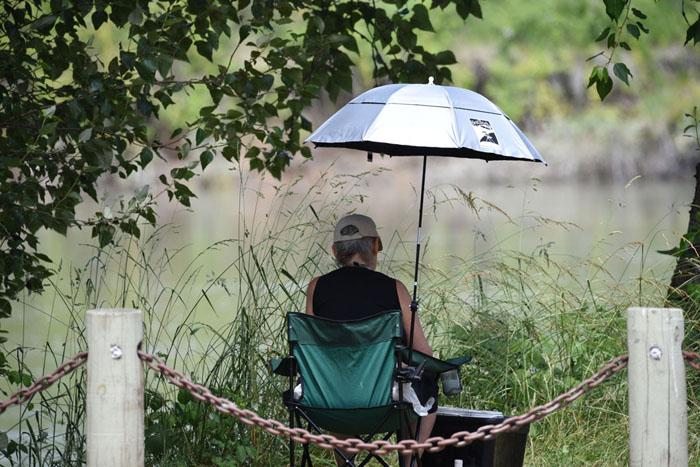Photo: Amy Gogarty. Photo credit Ray Gogarty
When did you graduate ACAD? (And what was it called then?) What was your major? Do you continue to work in this area or did you change areas of interest?
I graduated in 1980, when it was called ACA (Alberta College of Art)—at that time, all it offered was a diploma. I majored in Painting—I continue to paint, but now my painting is all on ceramic pots, which I make.
A lot of graduates use the ACAD degree as a creative stepping stone. So, what do you do? How has what you do evolved since graduation? How did your education at ACAD direct your career?
I am now retired from my “official” career—I taught for sixteen years in Liberal Studies at ACAD, and taught sessionally for three terms at Emily Carr University after moving to Vancouver in 2006. However, throughout my teaching career, I also wrote, published, edited, presented etc. catalogue essays, critical articles etc. (over 100 to date), something I continue to do. I exhibited my paintings throughout my years in Calgary—after moving to Vancouver, I changed the form of my art making. I continue to work in my studio, although given the complete change in community (Calgary to Vancouver), just about everything else relating to exhibiting has changed as well.
At ACAD, I was able to build a strong foundation in visual arts, which served me very well in my subsequent work. At ACAD, it was easy to believe one could have a career in art, that being an artist was a valid and important thing to be, and I gained the skills and confidence to continue on. One continues to learn throughout one’s life, but I can’t over-emphasize how important those four years were.
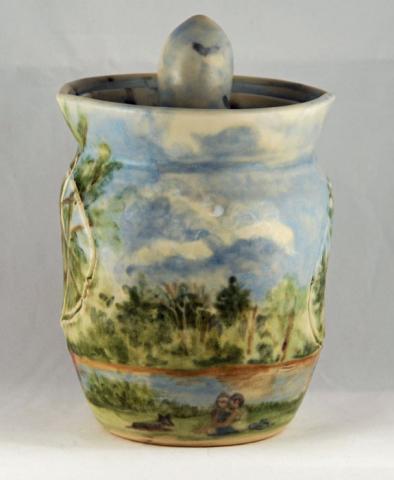
Left: Small lidded jar, 2016, Mid-fire white stoneware, underglaze, glaze. 18.5 cm high
What would you like to be recognized for?
As a human being, I hope to be recognized for being kind; as a teacher, supportive and encouraging; as a writer, someone who helped to articulate what motivates the artists about whom I wrote and who helped to further the discourse particularly for craft media; and as an artist, someone who made work that speaks to the incredible beauty and fragility of the world.
Given your experiences, what advice would you give a student when it comes to establishing a creative business?
My advice would be to get as much education as you can. Prepare yourself to be flexible and play the long game. Be on your toes so you can take advantage of opportunities as they present themselves—careers are rarely straight forward—they meander and take surprising turns. Don’t be narrow-minded in your focus or expectations, and understand that the world will change exponentially from the day you graduate on.
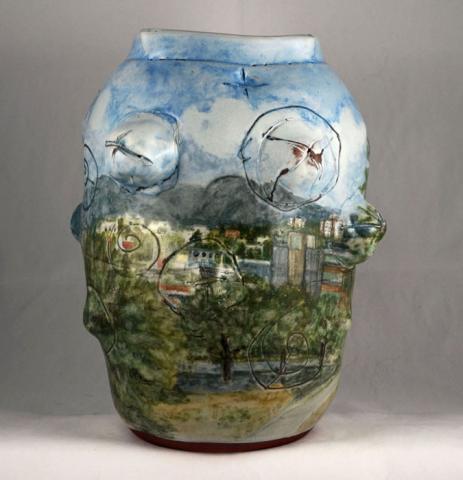
China Creek looking North and East, 2017, mid-fire stoneware, glaze, underglaze, 27.5 x 22 cm
What insights did your four (or one, two, three, five, six) years at ACAD give you when looking at things?
I had over twenty years at ACAD—four years as a student, three years as a textile technician and sixteen years as an instructor, so I definitely have the long view. Over that time, I learned to analyze the complexity of creative activities, unlearn hierarchies of disciplines and materials, respect students tremendously for having the courage to embark on a creative enterprise, respect faculty—as a student for all the assistance and encouragement they gave me, and as a colleague, seeing how hard they worked, the skills they possessed and how their point of view had validity, even if it was different diametrically from my own.
After graduation, what obstacles did you encounter and how did you overcome them?
I think the main obstacles were financial—the 1980s in Calgary were challenging financially, and the cultural atmosphere was not all that supportive of the creative arts. The artist-run network was really instrumental for building community and supporting younger artists, especially those not interested in a commercial career. I was probably more than a bit pig-headed, determined to be an artist at all costs, and I had a lot of luck—lucky to get the job at ACAD as a technician, lucky to go to grad school, lucky to be hired to teach at ACAD, and very lucky in my amazing colleagues. Although art is thought to be a very solitary, individualistic activity, my experience is that a healthy, vibrant and critically engaged community is essential to establishing and maintaining a creative career. I was really blessed to find that in Calgary.
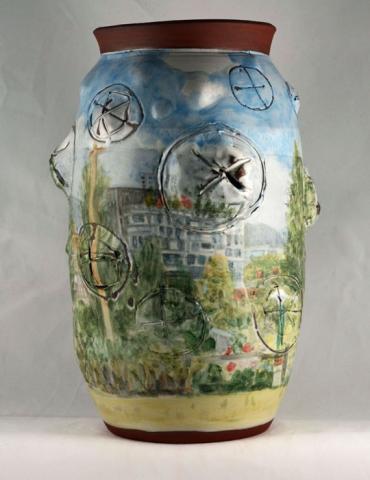
Tea Swamp Park, Summer, 2017, mid-fire stoneware, glaze, underglaze, 31 x 20 cm
How could you imagine ACAD supporting our alumni?
It’s a very different world today than when I graduated—things are much more about networking, Facebook, social media etc.—I expect that ACAD best supports its graduates by participating in those activities. It depends if you mean those graduates who remain in Calgary—for those, being a cultural resource in terms of exhibitions, speaker series, continuing education etc. are all very important. For those who move away, maintaining an active social media presence is important for the more recent grads. Highlighting successful grads (as in the alumni awards) is important, and perhaps organizing themed exhibitions with alumni, although so many people graduate and only a small number can be included in exhibitions—perhaps online exhibitions would be more appropriate.
Obviously by maintaining its excellent reputation ACAD helps its alumni in the most important way—the degree has meaning in the graduates’ fields of endeavour.
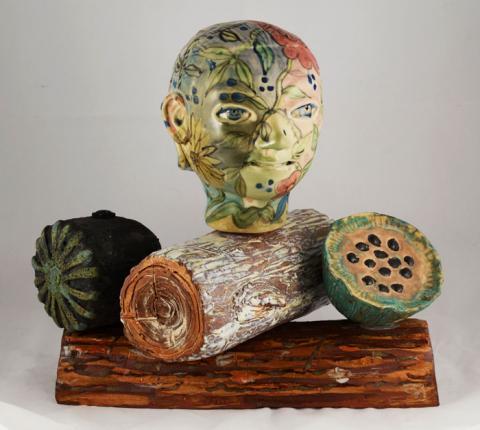
Urban/Nature 1, 2018 Cone six stoneware, electric fired, glaze, underglaze, steel bolts. 22 x 28 x 31 cm overall.
What do you feel is the role of ACAD and our alumni in shaping our cultural and economic prosperity? Looking back at our #ACADcreativitymatters campaign, why do you think that creativity matters in the big picture?
This campaign looks like it was very important for more recent grads and current students—these are the sorts of social media ventures to which I refer above. They are perhaps less important for less-recent grads (for many reasons, not the least of which is that social media is a culture of younger people).
Creativity is, at its heart, life itself. It takes many forms; it has its own rewards; it shapes the basic way we look at all things in life—all too often it is reduced to being a product. Perhaps as a product it most contributes to economic prosperity mentioned in your earlier question (which I’m not answering really because it is too complex for a short answer). The interesting thing, though, the “catch 22,” is that creativity is not always a friend of capitalism (often its direct opposite)—not something politicians and those dependent on their grace and favor like to think about. But for those of us interested in Slow Movements—social justice, ecology, craft activism, DIY culture etc., creativity allows us to live quite happily without all of the pollution and waste with which capitalism buries us. So it is a tricky thing—institutions need to promote the mantra of how much creative activity contributes to economic prosperity, but in reality, creativity helps us reconcile ourselves to, if not actively choose, lower levels of prosperity and consumption, allowing for more contemplation and joy in making.
Where does art fit into your future?
I make art every day and pay attention to others who make it, whether they call it art or not.
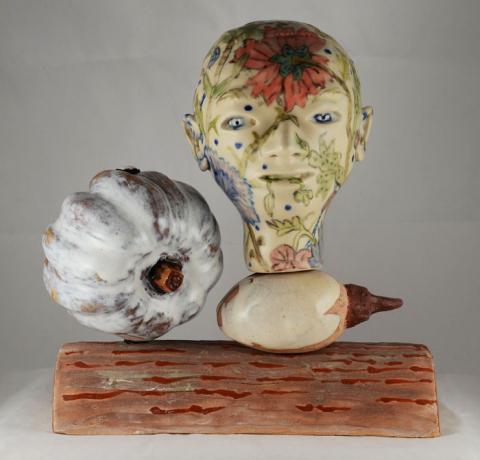
Urban/Nature 2, 2018. Cone six stoneware, electric fired, glaze, underglaze, steel bolts. 29 x 14 x 30 cm overall
Artist Statement
I am a painter who makes pots. For a long time, I searched for ways to bring together my two passions. Pots are in essence beautifully packaged pockets of space, and it is the space of the pot that interests me. Depicting the world around me, my pots bridge the visible world and the secret world of the pot’s interior. Working in the plein air tradition ensures a sort of mindfulness, a level of attention to the intricacy and beauty of the world, which I try to convey with my work.
My recent work comprises a series of small heads and other forms--acorns, squashes, peppers, rocks, logs--combined into small assemblages. The forms originate in my daily tasks and activities--caring for the garden, harvesting and preserving produce, walking--and in the faces I see around me in this diverse city. I try to reflect the ambiguity and non-binary diversity of ethnicity and gender, models of how we might go forward. The forms are pierced and threaded with metal rods, their combinations suggesting sentences or expressions. Similarity and difference play off each other, threading the world together.
